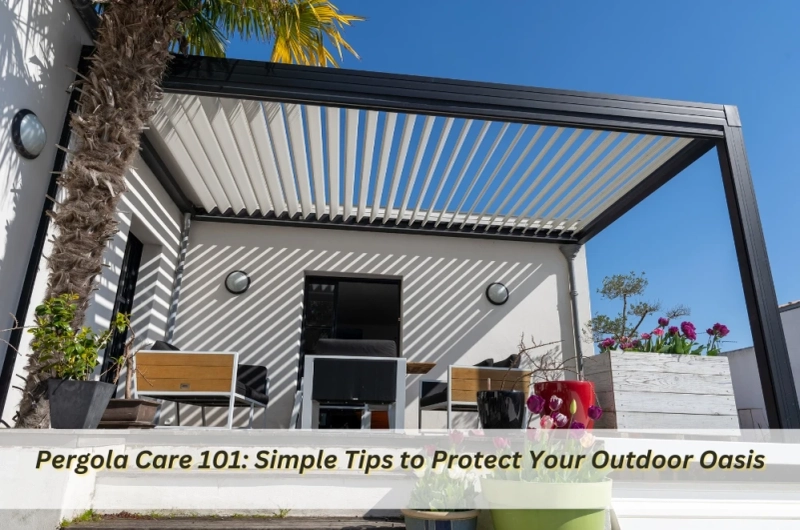There's something about sitting under a pergola on a warm, lazy Aussie afternoon with cold drinks in hands and the scent of eucalyptus in the air. Like all other types of outside structures, pergolas face cruel elements: the blazing sun, torrential downpours, and, on rare occasions, dust storms. But without proper maintenance, this great outdoors will eventually give in to faded finishes, corrosion, or even structural damage-and the oasis will become a bit of an eyesore. This guide gives some simple yet effective tips for caring for and maintaining pergolas for outdoor living to maximum enjoyment, ensuring they stand the test of time. A well-maintained pergola not only looks great, but it is safe and will provide enjoyment for many years to come.
How to keep your feature at its best
The secret to a long-lasting pergola is regular maintenance. It doesn't have to be hours each weekend but rather building up a routine that keeps the pergola at its best. This includes routine inspections, cleaning, and necessary precautions.
Regular inspection: These should be regularly inspected for any sort of damage, loose screws, or rusting in their metallic components. This helps to ensure that the problem, while small, does not grow big and costs an arm and a leg later on.
Cleaning: Regularly cleaning your pergola removes dirt, grime, and debris that contribute to deterioration. This is especially important after heavy rain or strong winds.
Protective treatments: These include special metal paints or coats that protect your structure from elements that may degrade it.
Unlocking the mysteries of maintenance with your pergola
Indeed, different pergola materials require different care. Whether you are focusing on maintenance or planning renovations to your pergola, understanding your pergola's construction specifics is indispensable for adequate upkeep. This section mainly deals with aluminium pergolas.
Aluminium pergolas: Resistance to rust and rot creates a great inclination towards the use of aluminium in making pergolas. Lightweight and strong, the metal is considered tough enough and low-maintenance too. While usually needing low maintenance, aluminium will benefit from cleaning now and then and the application of protectants to retain their look and prevent oxidation of the surface.
Roofing materials: Whether your pergola has shade cloth, polycarbonate sheeting, or another roofing material, it should be regularly cleaned and inspected for damage. Damaged sections should be replaced promptly for continued protection against the elements.
Tips for protecting your pergola from the elements
The Australian climate can be brutal, and protecting your pergola from the elements is paramount.
Sun protection: Severe Australian sun makes finishes fade on powder-coated aluminium. The actual aluminium does not get damaged from the sun, as can happen with timber; however, it is more of an aesthetic concern to keep its finish.
Water protection: Let the water drain appropriately around your pergola so that it does not gather around the bases of posts. This is essential even for aluminium to avoid corrosion inside the fixings or surrounding structures.
Wind protection: Severe wind can damage roofing material and the structure. Periodically check loose parts and ensure your pergola is well anchored.
During January, Australia is at peak summer, and people spend most of their time outdoors. The Australian Open tennis and other music festivals draw many people, so having a comfortable outdoor space is very important. This is also the time when it is crucial to protect your pergola, especially from the scorching sun.
Proactive maintenance: Preventing pergola damage
It is called proactive maintenance, a process in which measures are taken to prevent problems before they occur. For example, maintaining a pergola can transform your outdoor space, saving you time and money and causing fewer headaches while you try to fix the problem.
Fasteners-tightening: Regularly check for loose screws, bolts, and other fasteners and tighten them so that the component does not get loose or fall off.
Trimming overhanging vegetation helps remove branches and vines that reach for your pergola and rub against its face.
Cleaning gutters and downspouts: If the pergola has them, they should be cleaned of all the debris that may block their way to have the proper flow.
How to care for your pergola: A DIY project
Several maintenance tasks for your pergola can be readily done as DIY projects.
Maintenance wash: Cleaning your aluminium pergola is relatively easy; just use a mild detergent and a soft-bristled brush or a soft cloth for the wash down, and then thoroughly rinse with clean water. Harsh cleaning products should be avoided; these scratch the surface.
Protective coatings: Once an aluminium pergola is damaged or its powder coating is wearing off, special metal paint or coatings for aluminium may be applied. Since there may be different types on the market, you can consult a paint expert who is suitable for your aluminium pergola.
Replacement of defective components: The immediate replacement of the roof cladding components and fasteners and other damaged components
Of course, these maintenance routines are best undertaken during summer due to the more extended daytime period with more significant amounts of the sun. Then again, it is also appropriate to take ample precautions against possible heatstroke and sunburn.
Conclusion: Extend your pergola's beauty
A well-maintained pergola is genuinely priceless for any Australian home, creating spaces that will not only provide comfort for many years but also enjoyment. With these simple care and maintenance tips, you will be able to protect your pergola from the elements of costly repairs and keep it beautiful for many years. Make pergola improvements without spending a fortune by investing in regular maintenance—it’s much more than just keeping a structure intact; it’s about sustaining a space where memories are created, truly an outdoor retreat.



